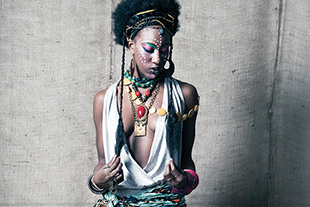Jess Dugan MFA ’14
Interviewer. Photographer. Advocate.
Photography MFA alum Jess Dugan highlights the lives and relationships of the trans and LGBT communities through portraiture.
The portraits of Jess Dugan MFA ’14 showcase raw vulnerability through fine details: graying hairs in a beard, healing surgical scars, hand placement, and a direct gaze from subject to viewer.
At Columbia College Chicago, Dugan shifted her focus from individuals on the trans-masculine spectrum (female-to-male) to photographing various people in the community she felt personally connected to as a broader exploration of the intersections of gender, sexuality, and identity. That shift led to her MFA thesis collection, Every Breath We Drew. In 2015, Dugan published her thesis as a book-length project through Daylight Books.
 Laurel, Every Breath We Drew, 2014
Laurel, Every Breath We Drew, 2014
After graduating, Dugan began working on a long-term photo-interview series, To Survive on this Shore, featuring members of the trans community who are more than 50 years old. Dugan discusses her process and the importance of photographing the LGBTQ community.
[What] drew me to photography was that it allowed me to connect with people on a very deep level. It allowed me to make work about my own identity (queer/gender non-conforming) and the identities of others in a way that felt meaningful. I want [viewers] to see the person I photographed the way I saw them and share that moment of connection. And secondly, I want them to think about the layers of my work: identity, gender, sexuality.
 Self-portrait (Muscle Shirt), Every Breath We Drew, 2013
Self-portrait (Muscle Shirt), Every Breath We Drew, 2013
I photograph in all natural light, and I usually go to my subject’s homes or personal spaces. You get [a better] sense of who they are, but more importantly, people feel a certain comfort in their own space and are more present. It’s very much about me slowing down the moment, creating this environment where that person feels seen, comfortable, and validated.
 Nicole, 56, Boulder, CO; To Survive on this Shore, 2016
Nicole, 56, Boulder, CO; To Survive on this Shore, 2016
To Survive on this Shore is specifically about people who are transgender and over the age of 50. I view that work as being more documentary—looking outward at other people’s stories. [My partner and I] met in Chicago, and we realized we had mutual interests. She focused on LGBT aging, and I’d been working within the trans and LBGT communities, so we decided to launch this project where we’d photograph and interview trans people who are over 50. At this point, we’ve interviewed and photographed 86 people across the country.

Kendrah, 72, Boston; To Survive on this Shore, 2015
One thing important to my work is providing visibility for people in marginalized communities and sharing their stories. My commitment is to include diversity in all realms, [including] race, gender identity and presentation, sexuality, socioeconomic status, geographic location, and life narrative. I’m trying to let these portraits be really complex, and as fully nuanced as the individuals themselves.

Dee Dee Ngozi, 55, Atlanta; To Survive on this Shore, 2016
I do think of my work as having an activist element. I want to encourage dialogue and raise awareness, and I think representation is critical. Not seeing yourself in the world around you can be really damaging. I also believe in photography as a storytelling medium and a way to allow people unfamiliar with the trans and LGBT communities an entry point to engage with people on a deeper level, even if it’s only through photographs. Once you know someone’s story, it’s so much harder to reduce them to a stereotype.
Images courtesy of the artist and Catherine Edelman Gallery.

Ryan and Josh, Every Breath We Drew, 2013










